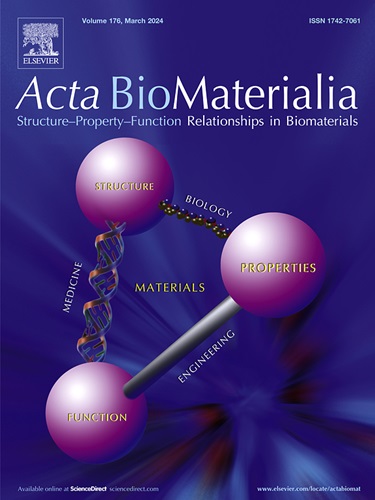Synthesis, characterization, and surface modification of degradable polar hydrophobic ionic polyurethane nanoparticles for the delivery of therapeutics to vascular tissue
IF 9.4
1区 医学
Q1 ENGINEERING, BIOMEDICAL
引用次数: 0
Abstract
Degradable polar hydrophobic ionic polyurethanes (D-PHI) are an emerging class of biomaterials with particular significance for blood-contacting applications due to their immunomodulatory effects and highly customizable block chemistry. In this manuscript, D-PHI polymer was formulated as a nanoparticle excipient for the first time by inverse emulsion polymerization. The nanoparticles were optimized with consideration of diameter, surface charge, size variability, and yield as a delivery vehicle for a custom vascular therapeutic peptide. A layer-by-layer (LBL) surface modification technique using poly-L-lysine was integrated within the nanoparticle design to optimize therapeutic loading efficiency. Solvent pH played a pivotal role in emulsion micelle formation, LBL polymer secondary structure, and the polymer functional group interactions critical for high therapeutic loading. The resulting nanoparticle platform met target size (200 ± 20 nm), polydispersity (<0.07), and storage stability standards, was nontoxic, and did not affect therapeutic peptide bioactivity in vitro. Surface-modified D-PHI nanoparticles can be reproducibly manufactured at low cost, generating a highly customizable excipient platform suitable for delivery of biomolecular therapeutics. These nanoparticles have potential applications in vascular drug delivery via localized infusion, drug eluting stents, and drug-coated angioplasty balloons.
Statement of significance
Nanoscale excipients have become critical in the delivery of many therapeutics to enhance drug stability and targeted biodistribution through careful design of nanoparticle composition, surface chemistry, and size. This manuscript describes the development of a nanoparticle excipient derived from an immunomodulatory degradable polar hydrophobic ionic polyurethane, in combination with a layer-by-layer surface modification approach utilizing poly-L-lysine, to transport a mimetic peptide targeting smooth muscle cell migration in vascular disease. The nanoparticle platform draws on the effect of pH to maximize drug loading and tailor particle properties. The low cost and easily reproducible system presents a highly customizable platform that can be adapted for therapeutic delivery across a wide range of clinical indications.

用于向血管组织输送治疗药物的可降解极性疏水性离子聚氨酯纳米粒子的合成、表征和表面修饰。
可降解极性疏水性离子聚氨酯(D-PHI)是一类新兴的生物材料,由于其免疫调节作用和高度可定制的嵌段化学性质,对血液接触应用具有特别重要的意义。本手稿首次采用反乳液聚合法将 D-PHI 聚合物配制成纳米颗粒赋形剂。考虑到纳米颗粒的直径、表面电荷、尺寸可变性和产量,对其进行了优化,使其成为定制血管治疗肽的输送载体。在纳米颗粒设计中采用了聚 L-赖氨酸逐层(LBL)表面修饰技术,以优化治疗负载效率。溶剂的 pH 值对乳液胶束的形成、LBL 聚合物的二级结构以及对高治疗负荷至关重要的聚合物官能团相互作用起着关键作用。由此产生的纳米粒子平台达到了目标尺寸(200 ± 20 nm)、多分散性(0.1%)和治疗效率(0.1%)。
本文章由计算机程序翻译,如有差异,请以英文原文为准。
求助全文
约1分钟内获得全文
求助全文
来源期刊

Acta Biomaterialia
工程技术-材料科学:生物材料
CiteScore
16.80
自引率
3.10%
发文量
776
审稿时长
30 days
期刊介绍:
Acta Biomaterialia is a monthly peer-reviewed scientific journal published by Elsevier. The journal was established in January 2005. The editor-in-chief is W.R. Wagner (University of Pittsburgh). The journal covers research in biomaterials science, including the interrelationship of biomaterial structure and function from macroscale to nanoscale. Topical coverage includes biomedical and biocompatible materials.
 求助内容:
求助内容: 应助结果提醒方式:
应助结果提醒方式:


